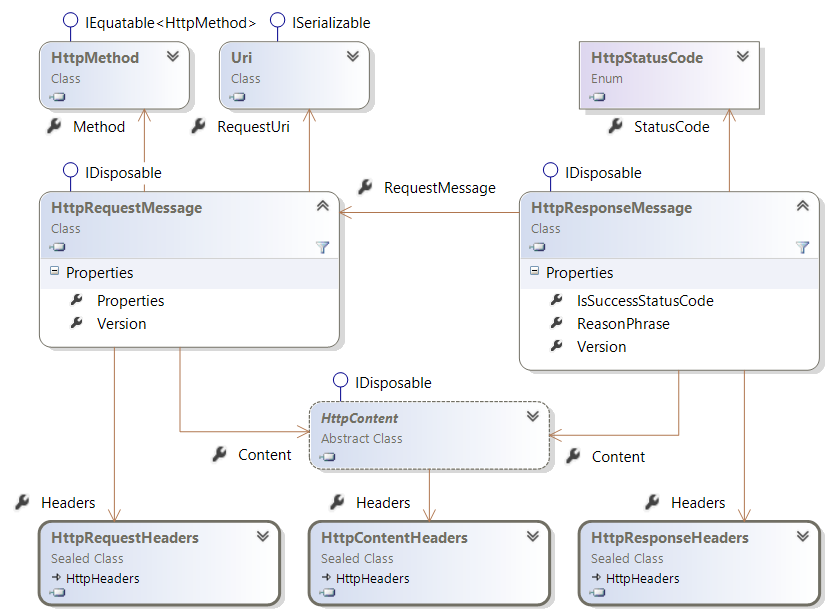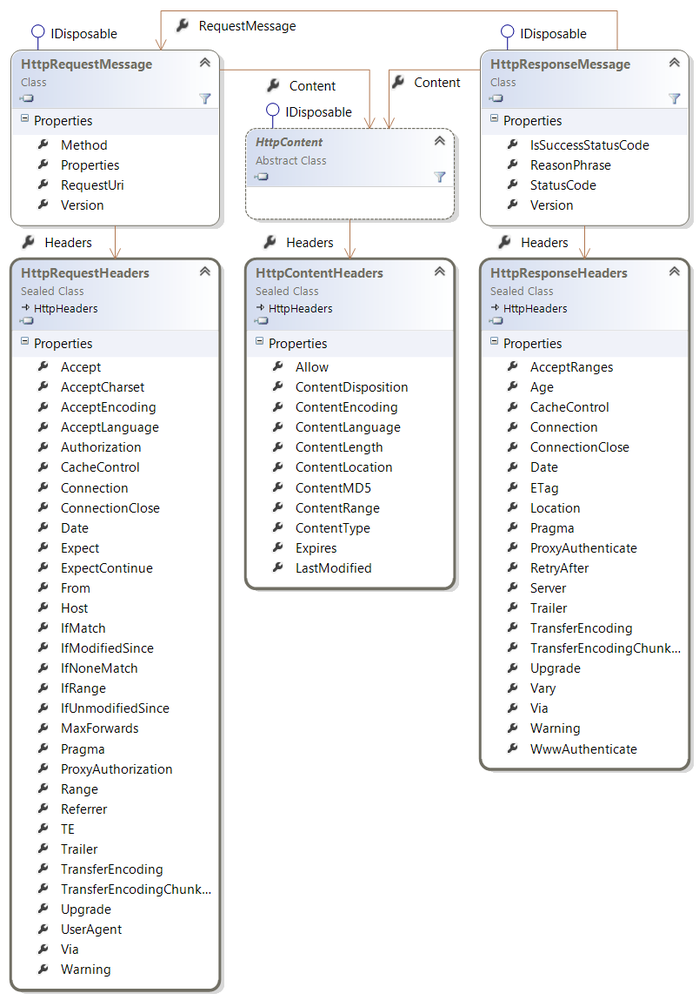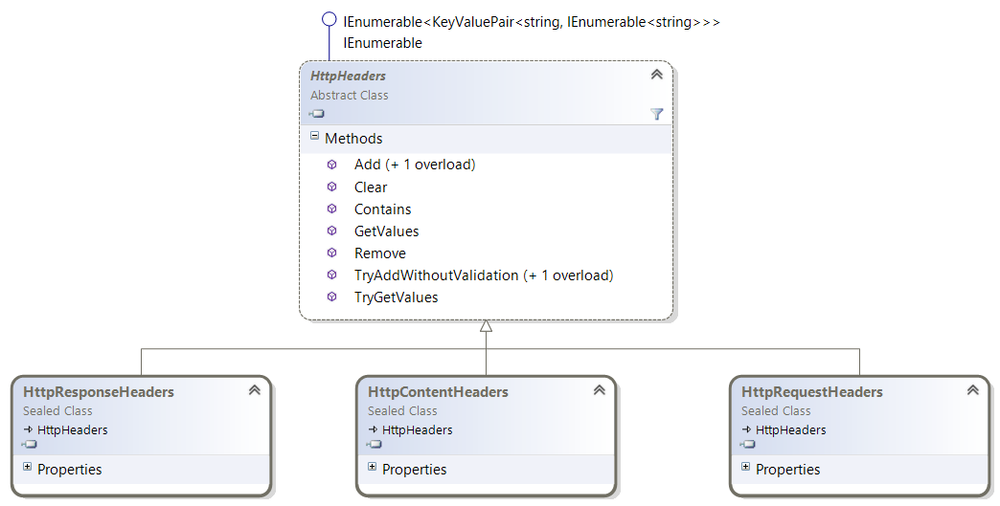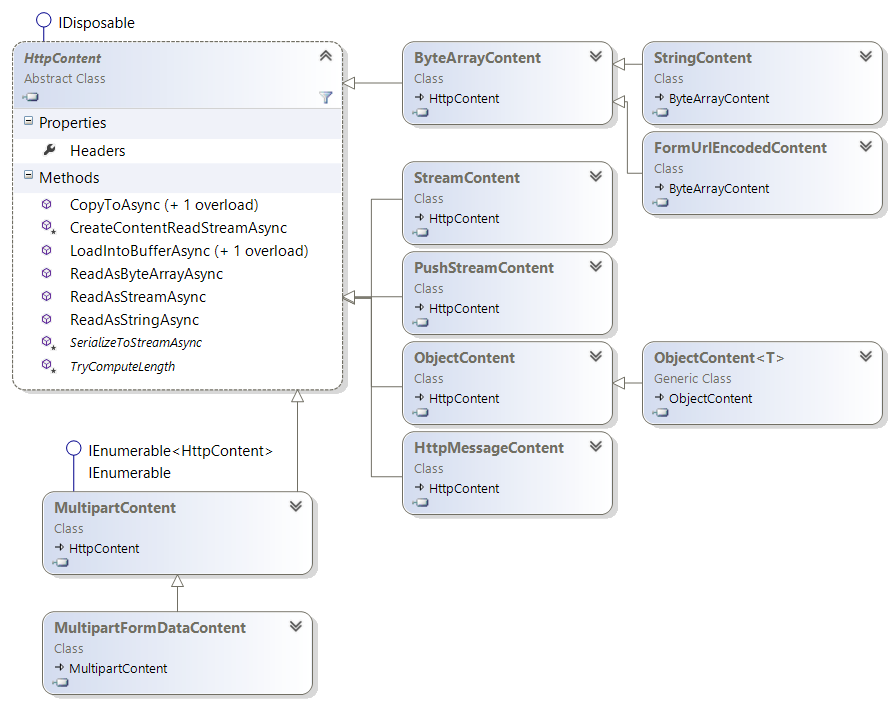Chapter 10. The HTTP Programming Model
The messages, the whole messages, and nothing but the messages.
This chapter presents the new .NET Framework HTTP programming model, which is at the core of both ASP.NET Web API and the new client-side HTTP support, specifically the HttpClient class.
This model was introduced with .NET 4.5 but is also available for .NET 4.0 via NuGet packages.
It defines a new assembly—System.Net.Http.dll—with typed programming abstractions for the main HTTP concepts (namely, request and response messages, headers, and body content).
This model is complemented by the System.Net.Http.Formatting.dll assembly, which introduces the media type formatter concept, described in Chapter 13, as well as some utility extension methods and custom HTTP content types.
This assembly is available via the “Microsoft ASP.NET Web API Client Libraries” NuGet package, and its source code is part of the ASP.NET project.
Despite its name, this package is usable on both the client and server sides.
In this chapter we will be describing features from both assemblies, without making any distinction between them.
The .NET Framework already contains more than one programming model for dealing with HTTP concepts.
On the client side, the System.Net.HttpWebRequest class can be used to initiate HTTP requests and process the associated responses.
On the server side, the System.Web.HttpContext and related classes (e.g., HttpRequest and HttpResponse) are used in the ASP.NET context to represent individual requests and responses.
Also on the server side, the System.Net.HttpListenerContext is used by the self-hosted System.Net.HttpListener to provide access to the HTTP request and response objects.
Unfortunately, all these programming models have several problems that the new one aims to solve.
Namely, the new System.Net.Http programming model:
- Uses the same classes on the client and server sides
-
Is based on the new Task Asynchronous Pattern (TAP), not on the old Asynchronous Programming Model (APM), meaning that it can take advantage of the
asyncandawaitlanguage constructs introduced with .NET 4.5 - Is easier to use in test scenarios
- Has a more strongly typed representation of HTTP messages—namely, by representing HTTP header values as types, not as loose string dictionaries
- Is more faithful to the HTTP specification, namely by not layering different abstractions on top of it
- Packages the more recent versions as a portable class library, allowing its use on a wide range of platforms
In the next sections, all these properties will become clearer as we present this new model in more detail. We begin by introducing the types for representing the fundamental HTTP concepts, namely request and response messages. Afterward, we show how both message and content headers are represented and processed via a set of specific classes. Finally, we end by showing how to produce and consume the message payload content.
Before we start, note that the old HTTP programming models are still used and supported; for instance, the ASP.NET pipeline is still based on the old System.Net.HttpWebRequest.
Messages
As presented in Chapter 1, the HTTP protocol operates by exchanging request and response messages between clients and servers.
Naturally, the message abstraction is at the center of the HTTP programming model, and is represented by two concrete classes, HttpRequestMessage and HttpResponseMessage, that belong to the new System.Net.Http namespace and are represented in Figure 10-1.
Both messages comprise:
- A start line
- A sequence of header fields
- An optional payload body
For requests, the start line is represented by the following HttpRequestMessage properties:
-
The request’s
Method(e.g.,GETorPOST), defining the request purpose -
The
RequestUri, identifying the targeted resource -
The protocol
Version(e.g.,1.1)
For responses, the start line is represented by the following HttpResponseMessage properties:
-
The protocol
Version(e.g.1.1) -
The request
StatusCode(a three-digit integer) and the informationalReasonPhrasestring
The response message also contains a reference to the associated request message, via the RequestMessage property.
Both the request and response messages can contain an optional message body, represented by the Content property.
In the section Message Content, we will address in greater detail how the message content is represented, created, and consumed, including a description of the HttpContent-based class hierarchy.
These two message types as well as the content can be enriched with metadata, in the form of associated headers. The programming model for dealing with these headers will be addressed in the section Headers.
The HttpRequestMessage and HttpResponseMessage classes are nonabstract and can be easily instantiated in user code, as shown in the following examples:
[Fact]publicvoidHttpRequestMessage_is_easy_to_instantiate(){varrequest=newHttpRequestMessage(HttpMethod.Get,newUri("http://www.ietf.org/rfc/rfc2616.txt"));Assert.Equal(HttpMethod.Get,request.Method);Assert.Equal("http://www.ietf.org/rfc/rfc2616.txt",request.RequestUri.ToString());Assert.Equal(newVersion(1,1),request.Version);}
[Fact]publicvoidHttpResponseMessage_is_easy_to_instantiate(){varresponse=newHttpResponseMessage(HttpStatusCode.OK);Assert.Equal(HttpStatusCode.OK,response.StatusCode);Assert.Equal(newVersion(1,1),response.Version);}
This makes these message classes very easy to use in testing scenarios, which contrasts with other .NET Framework classes used to represent the same concepts:
-
The
System.Web.HttpRequestclass, used in the ASP.NETSystem.Web.HttpContextto represent a request, has a public constructor but is reserved for infrastructure only. -
The
System.Web.HttpRequestBaseclass, used in ASP.NET MVC, is abstract and cannot be directly instantiated. -
The
System.Net.HttpWebRequestclass, used to represent HTTP requests on the client side, has public constructors, but they are obsolete. Instead, this class should be instantiated via theWebRequest.Createfactory method.
The HttpRequestMessage and HttpResponseMessage classes are also usable both on the client side and on the server side, because they represent only the HTTP messages and not other contextual properties.
This contrasts with other HTTP classes, such as the ASP.NET HttpRequest class that contains a property with the virtual application root path on the server, which obviously doesn’t make sense on the client side.
The request method is represented by HttpMethod instances, containing the method string (e.g., GET or POST).
This class also contains a set of static public properties with the methods defined in RFC 2616:
publicclassHttpMethod:IEquatable<HttpMethod>{publicstringMethod{get;}publicHttpMethod(stringmethod);publicstaticHttpMethodGet{get;}publicstaticHttpMethodPut{get;}publicstaticHttpMethodPost{get;}publicstaticHttpMethodDelete{get;}publicstaticHttpMethodHead{get;}publicstaticHttpMethodOptions{get;}publicstaticHttpMethodTrace{get;}}
To use a new method, such as the PATCH method defined in RFC 5789, we must explicitly instantiate an HttpMethod with the method’s string, as shown in the following example:
[Fact]publicasyncTaskNew_HTTP_methods_can_be_used(){varrequest=newHttpRequestMessage(newHttpMethod("PATCH"),newUri("http://www.ietf.org/rfc/rfc2616.txt"));using(varclient=newHttpClient()){varresp=awaitclient.SendAsync(request);Assert.Equal(HttpStatusCode.MethodNotAllowed,resp.StatusCode);}}
The response’s status code is represented by the HttpStatusCode enumeration, containing all the status codes defined by the HTTP specification:
publicenumHttpStatusCode{Continue=100,SwitchingProtocols=101,OK=200,Created=201,Accepted=202,...MovedPermanently=301,Found=302,SeeOther=303,NotModified=304,...BadRequest=400,Unauthorized=401,...InternalServerError=500,...}
We can also use new status codes by casting integers to HttpStatusCode:
[Fact]publicvoidNew_status_codes_can_also_be_used(){varresponse=newHttpResponseMessage((HttpStatusCode)418){ReasonPhrase="I'm a teapot"};Assert.Equal(418,(int)response.StatusCode);}
The HttpRequestMessage also contains a Properties property:
publicIDictionary<string,Object>Properties{get;}
This is used to hold additional message information, while it is being processed locally on the server or client side. For instance, it can hold information that is produced at the bottom layers of the processing stack (e.g., message handlers) and is consumed at the upper layers (e.g., controllers).
The Properties property doesn’t reflect any standard HTTP message part and is not retained when the message is serialized for transfer.
Instead, it is just a generic container for local message properties, such as:
- The client certificate associated with the connection on which the message was received
- The route data resulting from matching the message with the set of configured routes
These properties are stored in a dictionary and associated with string keys.
The HttpPropertyKeys class defines a set of commonly used keys.
Typically, these message properties are accessed via extension methods, such as the ones defined in the System.Net.Http.HttpRequestMessageExtensions class as follows:
publicstaticIHttpRouteDataGetRouteData(thisHttpRequestMessagerequest){if(request==null)throwSystem.Web.Http.Error.ArgumentNull("request");elsereturnHttpRequestMessageExtensions.GetProperty<IHttpRouteData>(request,HttpPropertyKeys.HttpRouteDataKey);}
The HttpRequestContext class, introduced with Web API v2, is another example of information that is attached to the request’s properties by the lower hosting layer and then consumed by the upper layers:
publicstaticHttpRequestContextGetRequestContext(thisHttpRequestMessagerequest){...returnrequest.GetProperty<HttpRequestContext>(HttpPropertyKeys.RequestContextKey);}publicstaticvoidSetRequestContext(thisHttpRequestMessagerequest,HttpRequestContextcontext){...request.Properties[HttpPropertyKeys.RequestContextKey]=context;}
Namely, this class aggregates a set of properties, such as the client certificate or the requestor’s identity, into one typed model:
publicclassHttpRequestContext{publicvirtualX509Certificate2ClientCertificate{get;set;}publicvirtualIPrincipalPrincipal{get;set;}// ...}
Headers
In HTTP, both the request and response messages, and the message content itself, can be augmented with information in the form of extra fields called headers. For instance:
-
The
User-Agentheader field extends a request with information describing the application that produced it. -
The
Serverheader field extends a response with information about the origin-server software. -
The
Content-Typeheader field defines the media type used by the representation in the request or response payload body.
Each header is characterized by a name and a value, which can be a list. The HTTP specification allows for multiple headers with the same name on a message. However, this specification also states that this is equivalent to only one header occurrence with both values combined. The set of registered HTTP headers is maintained by IANA.
As demonstrated in Figure 10-1, both the request and the response message classes have a Headers property referencing a typed header container class.
However, the content headers (e.g., Content-Type) are not in the request or response header collection.
Instead, they are in a content header collection, accessible via the HttpContent.Headers property:
[Fact]publicasyncvoidMessage_and_content_headers_are_not_in_same_coll(){using(varclient=newHttpClient()){varresponse=awaitclient.GetAsync("http://tools.ietf.org/html/rfc2616");varrequest=response.RequestMessage;Assert.Equal("tools.ietf.org",request.Headers.Host);Assert.NotNull(response.Headers.Server);Assert.Equal("text/html",response.Content.Headers.ContentType.MediaType);}}
Notice how the Server header is in the response.Headers container, but the ContentType header is in the response.Content.Headers container.
The HTTP programming model defines three header container classes, one for each of the header contexts:
-
The
HttpRequestHeadersclass contains the request headers -
The
HttpResponseHeadersclass contains the response headers -
The
HttpContentHeadersclass contains the content headers
These three classes have a set of properties exposing the standard headers in a strongly typed way.
For instance, the HttpRequestHeaders class contains an Accept property, declared as a MediaTypeWithQualityHeaderValue collection, where each item contains:
-
The
MediaTypestring property with the media type identifier (e.g.,application/xml) -
The
Qualityproperty (e.g.,0.9) -
The
CharSetstring property -
The
Parameterscollection property
The following excerpt shows how easy it is to consume the Accept header, since the class model provides access to all the constituent parts (e.g., quality parameter, char set):
[Fact]publicvoidClasses_expose_headers_in_a_strongly_typed_way(){varrequest=newHttpRequestMessage();request.Headers.Add("Accept","text/html,application/xhtml+xml,application/xml;q=0.9,*/*;q=0.8");HttpHeaderValueCollection<MediaTypeWithQualityHeaderValue>accept=request.Headers.Accept;Assert.Equal(4,accept.Count);MediaTypeWithQualityHeaderValuethird=accept.Skip(2).First();Assert.Equal("application/xml",third.MediaType);Assert.Equal(0.9,third.Quality);Assert.Null(third.CharSet);Assert.Equal(1,third.Parameters.Count);Assert.Equal("q",third.Parameters.First().Name);Assert.Equal("0.9",third.Parameters.First().Value);}
This feature greatly simplifies both the production and consumption of headers, abstracting away the sometimes cumbersome HTTP syntactical rules. These properties can also be used to easily construct header values:
[Fact]publicvoidProperties_simplify_header_construction(){varresponse=newHttpResponseMessage();response.Headers.Date=newDateTimeOffset(2013,1,1,0,0,0,TimeSpan.FromHours(0));response.Headers.CacheControl=newCacheControlHeaderValue{MaxAge=TimeSpan.FromMinutes(1),Private=true};vardateValue=response.Headers.First(h=>h.Key=="Date").Value.First();Assert.Equal("Tue, 01 Jan 2013 00:00:00 GMT",dateValue);varcacheControlValue=response.Headers.First(h=>h.Key=="Cache-Control").Value.First();Assert.Equal("max-age=60, private",cacheControlValue);}
Notice how the CacheControlHeaderValue class contains a property for each HTTP cache directive (e.g., MaxAge and Private).
Notice also how the Date header is constructed from a DateTimeOffset and not from a string, simplifying the construction of correctly formated header values.
Some header values are scalar (e.g., Date) and can be assigned directly, while others are collections represented by the HttpHeaderValueCollection<T> generic class, allowing for value addition and removal:
request.Headers.Date=DateTimeOffset.UtcNow;request.Headers.Accept.Add(newMediaTypeWithQualityHeaderValue("text/html",1.0));
Figure 10-2 shows the three header container classes, one for each header context. These classes don’t have public constructors and can’t be easily instantiated in isolation. Instead, they are created when a message or content instance is created.
The properties exposed by each one of these classes are restricted to the headers defined by the HTTP RFC.
For instance, HttpRequestHeaders contains only properties corresponding to the headers that can be used on an HTTP request.
Specifically, it does not provide a way to add nonstandard headers.
However, all three classes derive from an HttpHeaders abstract class, shown in Figure 10-3, which provides a set of methods for more low-level access to headers.
First, the HttpHeaders class implements the following interface:
IEnumerable<KeyValuePair<string,IEnumerable<string>>>
This provides access to all the headers as a sequence of pairs, where the header name is a string and the header value is a string sequence.
This interface preserves the header ordering and takes into account that header values can be lists.
The HttpHeaders class also contains a set of methods for adding and removing headers.
The Add method allows for the addition of headers to the container.
If the header has a standard name, its value is validated prior to addition.
The Add method also validates if the header can have multiple values:
[Fact]publicvoidAdd_validates_value_domain_for_std_headers(){varrequest=newHttpRequestMessage();Assert.Throws<FormatException>(()=>request.Headers.Add("Date","invalid-date"));request.Headers.Add("Strict-Transport-Security","invalid ;; value");}
On the other hand, the TryAddWithoutValidation method does not perform header value validation.
However, if the value is not valid, it will not be accessible via the typed properties:
[Fact]publicasyncvoidTryAddWithoutValidation_doesnt_validates_the_value_but_preserves_it(){varrequest=newHttpRequestMessage();Assert.True(request.Headers.TryAddWithoutValidation("Date","invalid-date"));Assert.Equal(null,request.Headers.Date);Assert.Equal("invalid-date",request.Headers.GetValues("Date").First());varcontent=newHttpMessageContent(request);vars=awaitcontent.ReadAsStringAsync();Assert.True(s.Contains("Date: invalid-date"));}
After seeing how message and content can be enriched with headers, in the next section we focus our attention on the content itself.
Message Content
In the new HTTP programming model, the HTTP message body is represented by the abstract HttpContent base class, shown in Figure 10-4.
Both the HttpRequestMessage and HttpResponseMessage have a Content property of this type, as previously depicted in Figure 10-1.
In this section, we will show how:
-
Message content can be consumed via the
HttpContentmethods. -
Message content can be produced via one of the existing
HttpContent-derived concrete classes or through the creation of a new class.
Consuming Message Content
When producing message content, we can choose one of the available concrete HttpContent-derived classes.
However, when consuming message content, we are limited to the HttpContent methods or extension methods.
In addition to the Headers property described in the previous section, the HttpContent contains the following public, nonvirtual methods:
-
Task CopyToAsync(Stream, TransportContext) -
Task<Stream> ReadAsStreamAsync() -
Task<string> ReadAsStringAsync() -
Task<byte[]> ReadAsByteArrayAsync()
The first one allows for the consumption of the raw message content in a push style: we pass a stream to the CopyToAsync method that then writes (pushes) the message content into that stream.
The returned Task can be used to synchronize with the copy termination:
[Fact]publicasyncTaskHttpContent_can_be_consumed_in_push_style(){using(varclient=newHttpClient()){varresponse=awaitclient.GetAsync("http://www.ietf.org/rfc/rfc2616.txt",HttpCompletionOption.ResponseHeadersRead);response.EnsureSuccessStatusCode();varms=newMemoryStream();awaitresponse.Content.CopyToAsync(ms);Assert.True(ms.Length>0);}}
The previous example uses the HttpCompletionOptions.ResponseHeadersRead option to allow GetAsync to terminate immediately after the response headers are read.
This allows the response content to be consumed without buffering, using the CopyToAsync method.
Alternatively, the ReadAsStreamAsync method allows for the consumption of the raw message content in a pull style: it asynchronously returns a stream, from where the content can then be pulled:
[Fact]publicasyncTaskHttpContent_can_be_consumed_in_pull_style(){using(varclient=newHttpClient()){varresponse=awaitclient.GetAsync("http://www.ietf.org/rfc/rfc2616.txt");response.EnsureSuccessStatusCode();varstream=awaitresponse.Content.ReadAsStreamAsync();varbuffer=newbyte[2*1024];varlen=awaitstream.ReadAsync(buffer,0,buffer.Length);vars=Encoding.ASCII.GetString(buffer,0,len);Assert.True(s.Contains("Hypertext Transfer Protocol -- HTTP/1.1"));}}
The last two methods, ReadAsStringAsync and ReadAsByteArrayAsync, asynchronously provide a buffered copy of the message contents:
the latter returns the raw byte content while the former decodes that content into a string:
[Fact]publicasyncTaskHttpContent_can_be_consumed_as_a_string(){using(varclient=newHttpClient()){varresponse=awaitclient.GetAsync("http://www.ietf.org/rfc/rfc2616.txt");response.EnsureSuccessStatusCode();vars=awaitresponse.Content.ReadAsStringAsync();Assert.True(s.Contains("Hypertext Transfer Protocol -- HTTP/1.1"));}}
In addition to the HttpContent instance methods, there are also extension methods defined in the HttpContentExtensions static class.
All these methods are variations of the following:
publicstaticTask<T>ReadAsAsync<T>(thisHttpContentcontent,IEnumerable<MediaTypeFormatter>formatters,IFormatterLoggerformatterLogger)
This method receives a sequence of media type formatters and tries to use one of them to read the message content as a T instance:
classGitHubUser{publicstringlogin{get;set;}publicintid{get;set;}publicstringurl{get;set;}publicstringtype{get;set;}}[Fact]publicasyncTaskHttpContent_can_be_consumed_using_formatters(){using(varclient=newHttpClient()){varresponse=awaitclient.GetAsync("https://api.github.com/users/webapibook");response.EnsureSuccessStatusCode();varuser=awaitresponse.Content.ReadAsAsync<GitHubUser>(newMediaTypeFormatter[]{newJsonMediaTypeFormatter()});Assert.Equal("webapibook",user.login);Assert.Equal("Organization",user.type);}}
Recall that media type formatters, presented in greater detail in Chapter 13, are classes that extend the abstract MediaTypeFormatter class and perform bidirectional conversions between objects and byte stream representations, as defined by Internet media types.
There is also an overload that doesn’t receive the media type formatter sequence.
Instead, it uses a set of default formatters, which currently are JsonMediaTypeFormatter, XmlMediaTypeFormatter, and FormUrlEncodedMediaTypeFormatter.
Creating Message Content
When creating messages with nonempty payload, we assign the Content property with an instance of an HttpContent derived class, chosen in accordance with the content type.
Figure 10-4 shows some of the available classes.
For instance, if the message content is plain text, then the StringContent class can be used to represent it:
[Fact]publicvoidStringContent_can_be_used_to_represent_plain_text(){varresponse=newHttpResponseMessage(){Content=newStringContent("this is a plain text representation")};Assert.Equal("text/plain",response.Content.Headers.ContentType.MediaType);}
By default, the Content-Type header is set to text/plain, but this value can be overriden.
The FormUrlEncodedContent class is used to produce name/value pair content, encoded according to the application/x-www-form-urlencoded rules—the same encoding rules used by HTML forms.
The name/value pairs are defined via an IEnumerable<KeyValuePair<string,string>> passed in the FormUrlEncondedContent constructor:
[Fact]publicasyncTaskFormUrlEncodedContent_can_represent_name_value_pairs(){varrequest=newHttpRequestMessage{Content=newFormUrlEncodedContent(newDictionary<string,string>(){{"name1","value1"},{"name2","value2"}})};Assert.Equal("application/x-www-form-urlencoded",request.Content.Headers.ContentType.MediaType);varstringContent=awaitrequest.Content.ReadAsStringAsync();Assert.Equal("name1=value1&name2=value2",stringContent);}
The programming model also provides three additional classes for when the content is already available as a byte sequence.
The ByteArrayContent class is used when the content is already contained in a byte array:
[Fact]publicasyncTaskByteArrayContent_can_represent_byte_sequences(){varalreadyExistantArray=newbyte[]{0x48,0x65,0x6c,0x6c,0x6f};varcontent=newByteArrayContent(alreadyExistantArray);content.Headers.ContentType=newMediaTypeHeaderValue("text/plain"){CharSet="utf-8"};varreadText=awaitcontent.ReadAsStringAsync();Assert.Equal("Hello",readText);}
The StreamContent and PushStreamContent classes are both used for dealing with streams:
the StreamContent is adequate for when the content is already available as a stream (e.g., reading from a file), while the PushStreamContent class is used when the content is produced by a stream writer.
The StreamContent instance is created with the stream defined in the constructor.
Afterward, when serializing the HTTP message, the HTTP model runtime will pull the byte sequence from this stream and add it to the serialized message body:
[Fact]publicasyncTaskStreamContent_can_be_used_when_content_is_in_a_stream(){conststringthisFileName=@"..\..\HttpContentFacts.cs";varstream=newFileStream(thisFileName,FileMode.Open,FileAccess.Read);using(varcontent=newStreamContent(stream)){content.Headers.ContentType=newMediaTypeHeaderValue("text/plain");// Assertvartext=awaitcontent.ReadAsStringAsync();Assert.True(text.Contains("this string"));}Assert.Throws<ObjectDisposedException>(()=>stream.Read(newbyte[1],0,1));}
The stream will be disposed when the wrapping StreamContent is disposed (e.g., by the Web API runtime).
There are, however, scenarios where the content is not already on a stream.
Instead, the content is produced by a process that requires a stream into which to write the content.
A typical example is XML serialization using a XmlWriter, which requires an output stream in which to write the serialized bytes.
A solution would be to use an intermediary MemoryStream where the stream writer writes the contents, and then give this memory stream to a StreamContent instance.
However, this solution implies an intermediate copy and is not well suited for streaming scenarios.
A better solution is to use the PushStreamContent class, which receives an Action<Stream, ...> and works in a push-style manner:
when the runtime has a stream available (e.g., the underlying ASP.NET response context stream), it calls the action with the stream.
It is the action’s responsibility to write the contents to this final stream, without any intermediate buffering:
[Fact]publicasyncTaskPushStreamContent_can_be_used_when_content_is_provided_by_a_stream_writer(){varxml=newXElement("root",newXElement("child1","text"),newXElement("child2","text"));varcontent=newPushStreamContent((stream,cont,ctx)=>{using(varwriter=XmlWriter.Create(stream,newXmlWriterSettings{CloseOutput=true})){xml.WriteTo(writer);}});content.Headers.ContentType=newMediaTypeWithQualityHeaderValue("application/xml");// Assertvartext=awaitcontent.ReadAsStringAsync();Assert.True(text.Contains("<child1"));}
An important aspect to highlight is that the action does not need to write all the contents synchronously.
In fact, the runtime considers the contents to be completely written only when the stream is closed, not when the action returns.
This means that the contents can be written by code scheduled by the action (e.g., asynchronous task or timer callback), after the action has returned.
The only requirement is that the stream’s Close method be called, in order to signal that the content is completely written.
Unfortunately, if an error occurs after the action returns, there is no way to signal it to the runtime.
The only possible behavior is to close the stream, which does not distinguish success from failure.
To address this problem, newer versions of the System.Net.Http.Formatting.dll assembly provide a PushStreamContent overload receiving a Func<Stream, HttpContent, TransportContext, Task>.
This allows the asynchronous code to return a Task, providing a way to signal the ocurrences of exceptions back to the runtime.
In the following example, note that the lambda expression is prefixed with async, meaning that it will return a Task:
[Fact]publicasyncTaskPushStreamContent_can_be_used_asynchronously(){conststringtext="will wait for 2 seconds without blocking";varcontent=newPushStreamContent(async(stream,cont,ctx)=>{awaitTask.Delay(2000);varbytes=Encoding.UTF8.GetBytes(text);stream.Write(bytes,0,bytes.Length);stream.Close();});content.Headers.ContentType=newMediaTypeWithQualityHeaderValue("text/plain");// Assertvarsw=newStopwatch();sw.Start();varreceivedText=awaitcontent.ReadAsStringAsync();sw.Stop();Assert.Equal(text,receivedText);Assert.True(sw.ElapsedMilliseconds>1500);}
The previous content classes require the content to already be represented as a byte sequence.
However, the new HTTP programming model also contains the ObjectContent and ObjectContent<T> classes, providing a way to define HTTP message content directly from an object.
Internally, these classes use media type formatters to convert the object into the byte sequence.
The following example shows the production of a JSON representation for an anonymous object with three fields.
Notice that the media type formatter used—JsonMediaTypeFormatter, in this case—must be explicitly defined in the ObjectContent constructor:
[Fact]publicasyncTaskObjectContent_uses_mediatypeformatter_to_produce_the_content(){varrepresentation=new{field1="a string",field2=42,field3=true};varcontent=newObjectContent(representation.GetType(),representation,newJsonMediaTypeFormatter());// AssertAssert.Equal("application/json",content.Headers.ContentType.MediaType);vartext=awaitcontent.ReadAsStringAsync();varobj=JObject.Parse(text);Assert.Equal("a string",obj["field1"]);Assert.Equal(42,obj["field2"]);Assert.Equal(true,obj["field3"]);}
The ObjectContent receives both the input object value and object type.
The generic version, ObjectContent<T>, is just a simplification where the input type is given as a generic parameter.
The new programming model also has a set of extension methods, contained in multiple HttpRequestMessageExtensions classes, that aim to simplify the creation of responses from requests.
For instance, you can create a response message that is automatically linked to the request message:
[Fact]publicvoidHttpRequestMessage_has_a_CreateResponse_extension_method(){varrequest=newHttpRequestMessage(HttpMethod.Get,newUri("http://www.example.net"));varresponse=request.CreateResponse(HttpStatusCode.OK);Assert.Equal(request,response.RequestMessage);}
You can also use a CreateResponse overload to create a representation from an object, given a media type formatter, similarly to what you can do with ObjectContent:
publicvoidCreateResponse_can_receive_a_formatter(){varrequest=newHttpRequestMessage(HttpMethod.Get,newUri("http://www.example.net"));varresponse=request.CreateResponse(HttpStatusCode.OK,new{String="hello",AnInt=42},newJsonMediaTypeFormatter());Assert.Equal("application/json",response.Content.Headers.ContentType.MediaType);}
The CreateResponse message is particularly useful in server-driven content negotiation scenarios, where the request information—namely, the request Accept header—is needed to decide the most appropriate media type:
[Fact]publicvoidCreateResponse_performs_content_negotiation(){varrequest=newHttpRequestMessage(HttpMethod.Get,newUri("http://www.example.net"));request.Headers.Accept.Add(newMediaTypeWithQualityHeaderValue("application/xml",0.9));request.Headers.Accept.Add(newMediaTypeWithQualityHeaderValue("application/json",1.0));varresponse=request.CreateResponse(HttpStatusCode.OK,"resource representation",newHttpConfiguration());Assert.Equal("application/json",response.Content.Headers.ContentType.MediaType);}
Notice how the used CreateResponse overload receives an HttpConfiguration with the configured formatters.
Finally, you also have the option of producing message content by creating custom HttpContent-derived classes.
However, before we present this technique, it is useful to understand how an HTTP message content length is computed.
Content length and streaming
In HTTP, there are three major ways to define the payload body length:
The last option exists mainly for compatibility with HTTP 1.0 and should not be used, since an abnormal termination of the connection will result in undetected content corruption.
With chunked transfer encoding, the message body is divided in a series of chunks, each with its own size definition. This allows streaming content, where the length information is not known beforehand, to be transmitted without buffering.
The first option is the simpler one, but it requires a priori knowledge of the content length.
For this purpose, the HttpContent class contains the following abstract method:
protectedinternalabstractboolTryComputeLength(outlonglength)
Each concrete content class must implement this method according to how the content is represented.
For instance, the ByteArrayContent class implementation always returns true, providing the underlying array length.
On the other hand, the PushStreamContent class implementation returns false, since the contents are pushed dynamically by the registered action.
Notice that there is no way for the PushStreamContent class to know how many bytes will be pushed by this action.
Finally, the StreamContent class implementation delegates this query to the underlying Stream, defined in the constructor:
if this stream is seekable, then the TryComputeLength method uses the Stream.Length to compute the content length;
otherwise, the TryComputeLength method returns false.
There is also a close relationship between the TryComputeLength method and the long? HttpContentHeaders.ContentLength property: when this property is not explicitly set, its value will query the TryComputeLength method.
This means that there is no need to explicitly set the Content-Length header, except in scenarios where this information is obtained by external methods.
Notice also that HttpContentHeaders.ContentLength is of type long?, allowing for the absence of value.
In Chapter 11, we will describe how this information is used by the hosting layer to determine the best way to handle the response message content (namely, to decide if buffering should be used or not).
Custom content classes
Now that we’ve seen how message content length is defined and what influences streaming, we will address the creation of custom content classes.
The following code excerpt shows the definition of the FileContent class: a custom HttpContent-derived class to represent file contents:
publicclassFileContent:HttpContent{privatereadonlyStream_stream;publicFileContent(stringpath,stringmediaType="application/octet-stream"){_stream=newFileStream(path,FileMode.Open,FileAccess.Read);base.Headers.ContentType=newMediaTypeHeaderValue(mediaType);}protectedoverrideTaskSerializeToStreamAsync(Streamstream,TransportContextcontext){return_stream.CopyToAsync(stream);}protectedoverrideboolTryComputeLength(outlonglength){if(!_stream.CanSeek){length=0;returnfalse;}else{length=_stream.Length;returntrue;}}protectedoverridevoidDispose(booldisposing){_stream.Dispose();}}
Creating a custom HttpContent class requires us to define the following two abstract methods:
protectedinternalabstractboolTryComputeLength(outlonglength)protectedabstractTaskSerializeToStreamAsync(Streamstream,TransportContextcontext);
As we saw in the last section, the first one—TryComputeLength—is used to try to obtain the content length.
In the FileContent implementation, this method uses the Stream.CanSeek property to query if the file stream length can be computed.
If so, it uses the Stream.Length property to return the content length.
The second method, SerializeToStreamAsync, is responsible for writing the contents to the passed-in Stream.
This method can operate asynchronously, returning a Task before the write is concluded.
This returned Task should be signaled when the write process is finally finished.
This asynchronous ability is useful when the message contents are provided by another asynchronous process (e.g., reading from the filesystem or from an external system).
For instance, the FileContent implementation takes advantage of the CopyToAsync method, introduced in .NET 4.5, to start the asynchronous copy and return a Task representing this operation.
Instead of deriving directly from HttpContent, you can take an alternative approach and use the StreamContent and PushStreamContent classes, either as a base class or via factory methods.
The following class shows you how to build XML-based content without requiring any buffering, by creating a PushStreamContent-derived class:
publicclassXmlContent:PushStreamContent{publicXmlContent(XElementxe):base(PushStream(xe),"application/xml"){}privatestaticAction<Stream,HttpContent,TransportContext>PushStream(XElementxe){return(stream,content,ctx)=>{using(varwriter=XmlWriter.Create(stream,newXmlWriterSettings(){CloseOutput=true})){xe.WriteTo(writer);}};}}
Since the PushStreamContent constructor requires an Action<Stream, HttpContent, TransportContext>, in the previous example we use a private static method to create this action from the given XElement.
Notice also the use of the XmlWriterSettings parameter in order to close the given stream.
Recall that, since the action is assumed to be asynchronous, the close of the stream signals the conclusion of this process.
We can accomplish the same goal by using an extension method on XElement:
publicstaticclassXElementContentExtensions{publicstaticHttpContentToHttpContent(thisXElementxe){returnnewPushStreamContent((stream,content,ctx)=>{using(varwriter=XmlWriter.Create(stream,newXmlWriterSettings(){CloseOutput=true})){xe.WriteTo(writer);}},"application/xml");}}
Conclusion
In this chapter, our focus was on the new HTTP programming model, which was introduced in version 4.5 of the .NET Framework and is at the core of both Web API and the new HttpClient class.
As we’ve shown, this new model provides a more usable and testable way of dealing with the core HTTP concepts of messages, headers, and content.
The following chapters build upon this knowledge to provide a deeper understanding of Web API inner workings.
Namely, Chapter 11 describes the interface between this model and a lower HTTP stack, such as the one provided by ASP.NET.
Get Designing Evolvable Web APIs with ASP.NET now with the O’Reilly learning platform.
O’Reilly members experience books, live events, courses curated by job role, and more from O’Reilly and nearly 200 top publishers.





